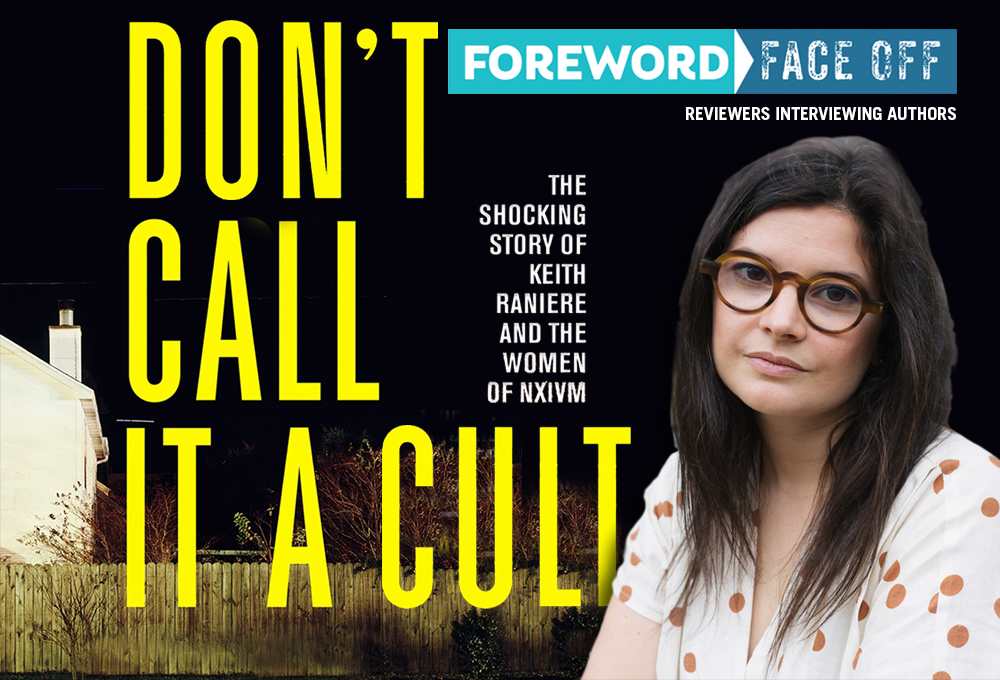Reviewer Claire Foster Interviews Sarah Berman, Author of Don’t Call It A Cult: The Shocking Story of Keith Raniere and the Women of NXIVM

Conspiracy theories and charismatic leaders with dictatorial ideas are the talk of our times. Many of us have lost faith in bedrock principles of government and society, leading to levels of division and polarization not seen in generations. Basic beliefs don’t seem to exist anymore.

Such are the conditions that cult leaders use to build their controlling fiefdoms, and this week Sarah Berman helps us understand how felon Keith Raniere pulled off his NXIVM villainy for twenty years in plain view of the authorities. Sarah’s Don’t Call It A Cult: The Shocking Story of Keith Raniere and the Women of NXIVM earned a starred review from Claire Foster in the May/June issue of Foreword, inspiring us to set up a conversation between reviewer and author. Thanks to Steerforth Press for help with the details.
Many of the women you interviewed in Don’t Call It a Cult were in the upper echelon of NXIVM and close to Keith Raniere, a charismatic cult leader. Their stories have some similar themes: many are wealthy white women who struggled to know what to do with their lives, prior to finding NXIVM. In spite of their privilege—which some people used to dismiss their stories—your book characterizes them as sympathetic victims of patriarchy. How did you center their vulnerability in this book?
One of the things that drew me to this story was the grey area between perpetrator and victim. For some of the women both labels apply and that’s OK. It’s a good thing to explore that kind of complexity. I was definitely looking for commonalities between the women’s experiences, and one of the themes I saw in each case was idealism. A lot of the women who made it to the upper ranks were white and privileged, yes, absolutely, but they joined NXIVM because they had a strong drive to help others. I thought it was so important to illustrate that, no matter how misguided or unbelievable their behaviour became over time, the women often thought they were doing good and making important sacrifices. They signed on to a self-improvement program that was supposed to make them stronger, but it came with hidden thought reform and social pressure techniques that over a period of years enforced ideas about women’s subservience to men. By the end of it, Raniere has a grip on everything important in their life, and has the ability to destroy their relationships and careers, as a way to make sure they never break with the group. As a journalist I wanted to understand what that looked and felt like from the inside so readers could see that for themselves.
NXIVM’s inner workings are fascinating; the book includes so many specifics, down to the sash colors of the cult’s “stripe path” or the shape of a bikini-area brand. The secret world of the cult is well-drawn, compelling, and even creepy. Is there any particular detail that has stuck with you from this project?
When Raniere faced trial in 2019, a whole universe of new evidence became public. I think one of the things that stuck with me the most was hearing a long series of WhatsApp messages between Raniere and one of his youngest so-called “slaves” read out loud in court. This was a woman who had been sexually exploited by Raniere when she was 15, and who remained in a secret relationship with him through most of her 20s. The messages revealed how he talked to her, which felt so much more devastating than the bare facts of the case. He never gave an inch. He was constantly testing her devotion and grinding away at her will to resist. It was heartbreaking to listen to.
You call out the role of the media in exposing Keith Raniere, and the book includes interviews with journalists from Times Union as well as clips from Forbes and New York Times Magazine. Why do you think the media seized the NXIVM story, and what might the outcome have been for Raniere if they had not?
I think the reporters who first dug into the NXIVM story starting in 2003 had an uphill battle ahead of them, because there were so many layers of secrecy obscuring what was really going on behind the scenes. I think Raniere anticipated there would be media interest and waged battle against his critics before they had a chance to dig too deeply. NXIVM practices also grew more extreme over time. I think readers and viewers have always had a fascination with cults because you have people acting outside their own best interests, and it seems so hard to explain. It’s an unbelievable story.
In 2017 you started to see a snowball effect, where the abuses were finally sticking and starting to make sense to people, and the pressure to investigate became harder to ignore. You had a lot of elements that created the outcome—former members leaving, blowing the whistle, and putting pressure on authorities through a sustained media campaign. Take away any one element and I can imagine an alternate ending where Raniere leaves the United States with his followers and is never prosecuted.
Don’t Call It a Cult is about so much more than just Raniere and his organization. The book alludes to issues of gender, power, and wealth in the larger culture and interprets their implications. What lesson do you think NXIVM ultimately teaches us?
I think this is a case that illustrates how our beliefs and morals aren’t static, they’re always changing and can be influenced by our closest friends and family. One of the lessons I took away from reporting on this story is that we’re constantly bouncing ideas off of the people we care about, and they’re informing our decisions. When there’s a breakdown in that network, we’re more vulnerable to undue influence. This is a lesson you can see playing out with the rise of QAnon and the far right. When society is fragmented, more of us are going to get caught up in beliefs and causes that don’t serve us. It’s healthy to get a variety of perspectives from people who care about you.
Claire Foster
